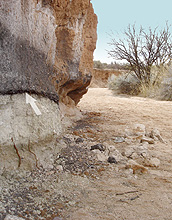During the ice age that started suddenly, many species became extinct, including the mammoths. The accepted theory says that the extinction was done by the first Indians who entered North America from Siberia

The layer marked with an arrow indicates the extinction of the mammoths in North America. Credit: Allen West, UCSB (University of California, Santa Barbara, from press release)
Scientists believe they have found a solution to a mystery that has fascinated paleontologists for years: what caused the sudden onset of an ice age 12.9 thousand years ago and the extinction of large mammals. The accepted theory says that when the first humans - hunters who came to North America from Siberia, killed the large and tasty mammals, when the breeding capacity of these mammals was lower than the hunter's rate. However, there is now also evidence that a small comet exploded over North America around the same time. Such an explosion can also cause cooling and the death of many animals.
The period in question is called the Younger Dryas, a period of extraordinary cooling that lasted about a thousand years at the beginning of the period of global warming and the melting of glaciers after an ice age. The evidence of temperature changes was taken from marine sediment records and ice cores taken from the poles.
The discovery was made by scientists from the University of California at Santa Barbara. They analyzed over a dozen archaeological sites all over North America and found that all of them had a high concentration of iridium. This element is a rare element on Earth, but is abundant in comets and asteroids. When these objects hit the Earth, they leave a blanket of iridium behind them, which serves as a marker. When archaeologists dig through layers of soil, they look back in time and can date when the bone hit.
If the theory is proven, then it is a comet with a diameter of about 4 km that exploded in the sky over North America and left fragments all over the area. The high temperatures must have ignited wildfires across and along the continent, destroying the vegetation that the large mammals needed to survive. Their death will lead to a chain of deaths of the large predators and the rest of the food chain that relies on them.
"The comet may have caused instability in large parts of the ice cap and caused a large volume of water to flow into the oceans. Climate scientists believe that this type of event can disrupt the water cycle in the oceans and lead to a global cooling event. Ecosystems all over the planet have suffered as a result.
Ancient cultures such as the Clovis people of North America relied on mammoths and other large animals for food. They were affected by the damage, and this also caused their culture to fall.
James Kent, a paleo-oceanographer at the University of California, Santa Barbara, says the discovery may explain some of the most controversial geological processes in recent decades.
